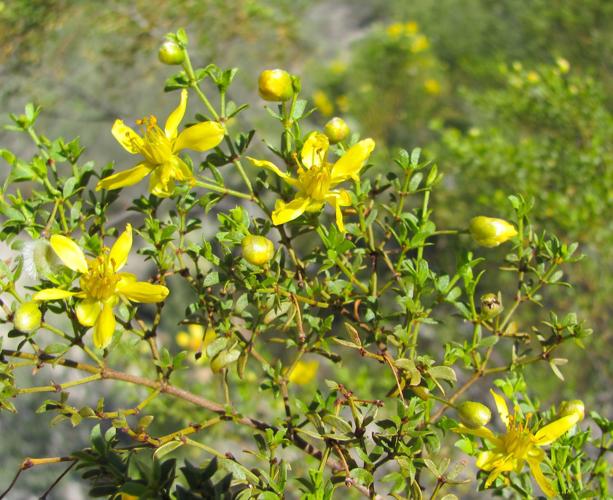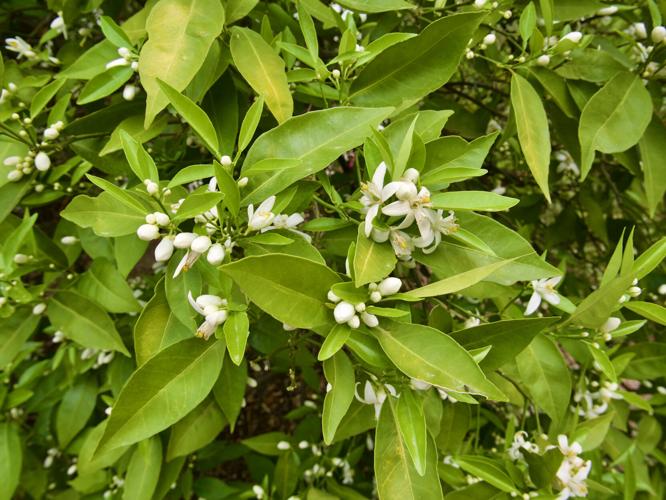Gardeners tend to focus on a garden’s appearance, but a well-rounded yard can please all the senses. One of the joys of plants is their wonderful scents, which range from sweet to spicy to pungent.
A good way to get some scents into your garden is to plant herbs such as thyme, basil, rosemary, and mint. Below are some of my favorite scented plants which do well in our climate, including some natives.
Creosote (Larrea tridentata): This native shrub is responsible for that heavenly “wet desert” smell when we get rain. It’s a little sharp, somewhat spicy, and soothing. It also provides great habitat for various native insects including bees; can handle reflected sun and heat; and won’t require any watering once it’s established. The trick with getting them to establish in your yard is to plant it as soon as possible (they don’t like being in containers) and not to overwater them. Water deeply a couple of times in the week or two after planting, then switch to weekly watering for a couple of weeks, and then water once a month until you see it grow. After that, leave it alone!
Desert lavender (Condea/Hyptis emoryi): Another shrub native to our desert, this plant has a medium growth rate and beautiful lavender-colored flowers during warm weather. The foliage has a pleasant light herbal scent which is more intense when it gets wet. It’s also a great habitat plant for birds and insects.

This orange gives off a sweet, refreshing fragrance when blooming. Citrus grow well in Tucson given the right conditions.
Citrus (Citrus spp.): If you’ve walked outside in Tucson during mid-spring, you know the heady, lush smell of citrus trees in bloom. Any of the varieties will have a great scent, and usually flower in March for a couple of weeks. For information on choosing the right citrus for you, check out this helpful guide from Civano Nursery.
Chocolate flower (Berlandiera lyrata): This native is a short, perennial flower with a daisy-like appearance. As the name suggests, it smells like chocolate. It does require some supplemental irrigation during the hot months, but will flower during most of the warm season. It is a good plant for attracting pollinators.

Lavender originated in the Mediterranean region and is well-adapted to our climate. It has a spicy, rich fragrance.
Lavender (Lavandula spp.): Lavender originated in the Mediterranean region, so it’s fairly well-suited to our climate. It’s natural habitat is sunny, rocky, well-drained soil. It can also be grown in containers, although I have found that it likes some afternoon shade if it’s not planted in the soil. Harvest the flowering stems regularly to keep the new ones coming. It will bloom through most of the spring and into summer if watered.

Cleveland sage is a near-native to Tucson. It is very aromatic and its leaves can be used in cooking.
Cleveland sage (Salvia clevelandii): Despite its name, this is a near-native shrub from southern California and Mexico. The foliage has a wonderful herbal scent, and it can be used for cooking. It’s a nice habitat plant for birds and pollinators, and has beautiful purple flowers. It can grow quite large, so make sure you give it space. It can also be grown in large containers.

Pink jasmine grows well in Tucson in part shade. It has a heady, sweet aroma.
Jasmine: This is a favorite with many people. You can find star jasmine (Trachelospermum jasminoides) or pink jasmine (Jasminum polyanthum) easily in local nurseries. There are a number of other varieties, as well. In Tucson, jasmines grow best in part shade and need a fair amount of supplemental water (two deep waterings per week once established). It tends to flower in March for a couple of weeks. It’s a versatile plant, since it can be trellised as a vine, planted in containers, or left to grow in a large clump.









